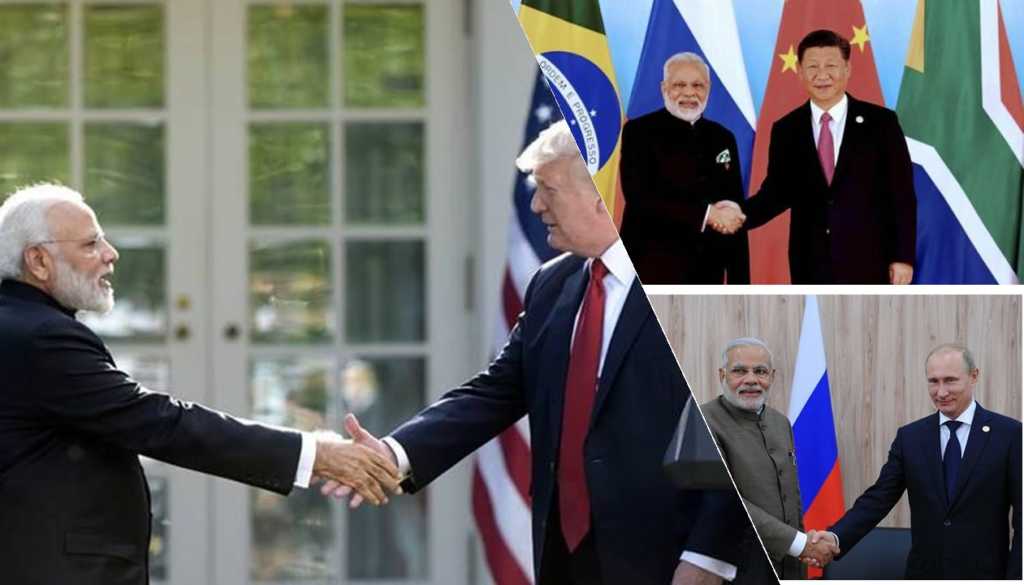On 27th April 2018, PM Modi met his Chinese counterpart President Xi Jinping during the informal two-day relation-building summit in the central Chinese city of Wuhan. The meeting termed as the ‘new beginning’ in Chinese media comes in the backdrop of 72 days standoff at Doklam. The two Asian giants now have broken the ice and PM Modi has extended an invitation to President Xi to visit India in 2019. Although the meeting was an informal one but it was in the making since Xiamen meeting, when two leaders attended the 9th BRICS Summit. It is popularly known in diplomatic circles that larger countries should adjust the pivot from hawk to dove to ease tensions in order to avoid friction between giant economies, with trade being the axis the realignment is easy.
Now since Sino-Indian relationship is on the right track and expected to get better, it’s time for India to realign with the other powers of the world. The traditional “Non-alignment” policy has been given a decent entombment and key-global clout diplomacy is being practiced on the basis of strict mutuality. The traditional nonaligned brashness needs to be reshaped to accommodate a fast-changing world. The recent policy realignment of using the pressure points around Chinese periphery with a non-hesitant approach to collaborate with the powers like the US, Japan and Australia to stabilize the Indo-Pacific has done wonders. While segments of the Indian intellectual institution and establishment still retain impulsively anti-American, PM Modi with his “I do what I do” attitude ,sculpts a new partnership with the US to harness its capital and technology for his domestic development agenda.
India has signed logistics agreement with France and US. The reflexive anti-American or west beliefs have often restricted India from harnessing the true potential of defense and strategic ties with US & the West. But PM Modi is not ambivalent about positioning India as a Partner or a challenger. The basic agreement LSA (Logistics Supply Agreement), CISMOA(Communication and Information Security Memorandum of Agreement), and BECA (the Basic Exchange and Cooperation Agreement) aren’t predominantly exhilarating agreements. Undoubtedly, none of them characterize anything avant-garde. Instead, they are the stepping stones for a deeper U.S.-India defense partnership.
The LSA – It establishes a framework for the two countries to share military logistics. Under the collaboration agreement, both the countries will have the ability, but not the obligation, to assist each other’s armed forces with simple military logistics.
The LSA was renegotiated and it was tailored for the Indian needs and the new signed agreement between New Delhi and Washington is called Logistics Exchange Memorandum of Agreement (LEMO)
CISMOA, meanwhile, would allow the United States to supply India with its exclusive encrypted communications equipment and systems, allowing secure peacetime and wartime communication between high-level military leaders on both sides. Currently India operates a fleet of C130 Super Hercules, C 17 Globe master III and other US origin equipment’s on the commercially available communication systems.
BECA will establish a framework through which the United States could share sensitive data to aid targeting and navigation with India. If India decides to make any Missile or fighter jets of American origin made in India, it will require the targeting and navigational systems which are not available without signing the BECA.
The picture isn’t as rosy as it appears as a basic agreement for the technological transfer has a flip side to it, the agreement could bind United States and India so closely that it may start hurting India’s leading defense equipment supplier “Russia”. Although India-Russia relationship is a subject of debate but with a financially weakened Russia inching towards Rawalpindi, New Delhi will have to re-calibrate its options. Like LEOMA the other two basic agreements can be renegotiated so as to utilize the Indo-American joint partnership to the fullest.
As many Analysts and critics say, “Russia cannot afford losing India for Pakistan”, and they have balanced India and china pretty well. Similarly, India can also collaborate with US, the west and Russia. A poised India should be able to contravene easily if its economic fundamentals remain strong. What India needs right now is to shape its Defense policy and PM Modi has the potential and the willpower to gradually but decisively shift Indian foreign policy in right direction. The opposition might disagree, but Indian foreign policy will look very different with PM Modi at the helm for next term. The best way could be a formal or informal visit of president of United States Donald trump to meet his Indian counterpart in India.
The decisive shift to the “Right” in Indian policy has been the fundamental change in the government establishment and this has paved the path for India’s rise as a global power. The foreign policy compass reads direction as “Right” and it will be interesting to see the next stop in this voyage.
